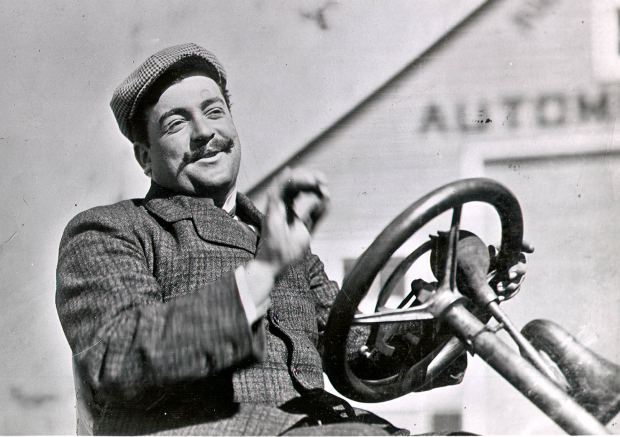Driver Profile: Vincenzo Lancia

A natural mechanical engineering genius, Vincenzo Lancia was born in Fobello, Italy August 21, 1881, the son of a wealthy country squire and soup canner. He received his formal education at the Turin Technical School studying bookkeeping. That background proved a poor predictor of his life’s direction.
Life, as it frequently does, opened a world of unexpected possibilities for the young man when his family rented a portion of their winter estate to Matteo Ceirano who owned a mechanical shop and would eventually produce automobiles under the Itala brand. Vincenzo was fascinated by Ceirano’s work and convinced his father to let him take a job as the shop’s bookkeeper. Immediately, Lancia set about absorbing everything his eyes could take in about the craft of mechanics and the art of design. Only a teenager, his aptitude for engineering astonished Ceirano and his chief engineer, Faccioli. His relentless work ethic earned him opportunities with mechanical design projects far afield from bookkeeping. When Ceirano’s firm was acquired in 1899 by Fiat the 18-year old Lancia’s reputation was so well established that he was appointed chief inspector at Fiat’s new factory.
Lancia was also invited to join the Fiat race team as one of four drivers that included Felice Nazzaro, Alessandro Cagno and Luigi Storero. Almost immediately he took a victory at a race meet at Padua. Lancia’s greatest moment at the wheel came in his brilliant victory in the 1904 Florio Cup. He stormed across the finish line of the 230-mile race with the then-astounding speed average of 71.88 miles per hour.
Unfortunately, this would not be the norm in a driving career that spanned 10 years. During that time he was frequently very fast but would almost as frequently fail to finish through mechanical breakdowns or accidents. Few better examples of his dominance and failure exist than Lancia’s drive for the first seven laps of the 1905 Vanderbilt Cup Race.
Lancia’s first lap at 71.3 miles per hour proved to be faster than any other driver would record in the entire race. Still, he bettered that mark in each of the next three successive laps, setting a race-high speed of 72.9 miles per hour on the fourth circuit. Other competitors wilted as Lancia continued his onslaught. By lap 7 only 9 cars were still in the running. Just as it appeared Lancia was untouchable, the unthinkable happened on lap 8. In a precautionary move Lancia had decided to take advantage of his huge lead – at that point a lap on the entire field – by stopping for new tires at his Fiat station just east of Albertson.
His tire men were efficient and Lancia was ready to return to the course in about 16 minutes. With Walter Christie fast approaching, flagmen shouted, “Car Coming!” and frantically waved their flags. Taking an impossible risk the impatient Italian pulled out into the path of the oncoming American racer. Christie swerved, but the road was not wide and his wheels partially slipped into a ditch in his evasive effort. The two cars hooked rear wheels, and the Christie swung 180 degrees around, throwing the driver and his mechanician, Nicholas Leightner, out of the machine. Christie was up and about immediately, but Leightner was taken by ambulance to Mineola Hospital. Their car was a mess, the rear wheels crushed. While Lancia continued on after his crew affected repairs, his race was lost. He finished fourth behind Victor Hemery, George Heath and Joe Tracy in the Locomobile.The crash was captured in this wonderful Peter Helck painting.
Lancia returned with Fiat to again vie for the Vanderbilt Cup in 1906 but could not match Louis Wagner and his dominant Darracq. Wagner led from start to finish, with Lancia in second most of the way. Lancia finished a strong, but disappointing, second place and would never again drive for the Vanderbilt Cup. Lancia can be seen driving his #4 Fiat in this film of the 1906 race. As seen in this photo, the cameraman for the film was standing to the left of the car.
Lancia’s greatest accolade from Fiat might have been when he left the firm to establish his own company in 1907 but was retained by his former employer as a driver on their racing team. Even though the new company was named after Lancia, he created it with a partner, Claudio Fogolin, a colleague from his Fiat days. As might be expected, a hallmark of the company was engineering excellence, an attribute that remains a part of the brand that still exists today. Even the car’s names were distinctive, borrowing from the Greek alphabet for the Alpha, Beta, Didelta, Gamma and Epsilon models.
Like with all car companies, Lancia was confronted with the challenges of World War I weapons production. Following that conflict, the company found its bearings. With the rollout of the Lambda in 1923, Lancia won acclaim among the elite of automotive designers as he introduced the concept of independent front suspension for what was widely regarded as the most precise steering available anywhere. Lancia continued to pursue automotive perfection until his untimely death at age 55, the victim of a heart attack on February 15, 1937. His son Gianni ran the firm until 1955 when he sold his interest to investor Carlo Pesenti after a brush with bankruptcy. Fiat acquired Lancia in 1969 and the company remains a part of that automotive group today. More photos on Vincenzo Lancia can be found on this VanderbiltCupRaces.com search.
Links to related posts on VanderbiltCupRaces.com:
Archives: Drivers and Mechanicians











Comments